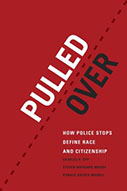Pulled Over: How Police Stops Define Race and Citizenship

Authors: Charles R. Epp, Steven Maynard-Moody, and Donald Haider-Harkel
Publisher: Chicago: University of Chicago Press, 2014. 274p.
Reviewer: Andrew Gelman | September 2014
Fifteen years ago I was contacted by Jeff Fagan, a professor of public health at Columbia
University, about a project he was working on with the New York State Attorney General’s Office, studying the rate of police stops of whites, blacks, and Hispanics in New York City. Police records revealed that ethnic minorities were being stopped at a much greater rate than whites. Defenders of the system argued that the patterns of stops represented a reasonable set of choices given the information available to police. As Howard Safir, the police commissioner at the time, stated, "The racial/ethnic distribution of the subjects of ‘stop and frisk’ reports reflects the demographics of known violent crime suspects as reported by crime victims. Similarly, the demographics of arrestees in violent crimes also correspond with the demographics of known violent crime suspects." This seemed implausible, though, given that minorities were stopped much more often than whites, even if the baseline being used was not population but rather their rates of arrests in the previous year.
One suggestion was that the data on ethnic breakdowns represented differential treatment at the neighborhood rather than the individual level: many parts of the city with dense populations of ethnic minorities also have high crime rates. To address this concern we performed a series of multi-level analyses predicting the rate of police stops for different ethnic groups for different categories of crime, controlling for precincts and previous year’s arrest rates. The disparity between whites and others remained large, indicating that the police were disproportionately stopping minorities even within local areas.
As we wrote at the time, these statistical patterns do not necessarily imply active discrimination on the part of the police. One possible explanation is that members of different ethnic groups are more or less likely to be hanging out on the street, where the stops are taking place. One might also argue that disproportionate stops are not such a problem because a stop, and even a frisk, is just a way for police to get information; indeed, the overwhelming majority of stops do not lead to immediate arrests. Yet another explanation, familiar to scholars who study stereotyping, has to do with the macro effects of micro-decisions. If, as indeed is the case, that a randomly-chosen African-American man is more likely to have a criminal record, compared to a white man, then in settings with little or ambiguous information it would be logical for a police officer to go with that background information. But all these choices, reasonable as they might be for individual cases, would have a negative aggregate impact on ethnic minority groups in the city.
When our report with these findings was released in 1999, I was surprised that the representatives of the city government and the police department did not justify their policies based on any of these just-mentioned arguments. Instead they questioned various aspects of our analysis and argued that the police had not stopped minorities at disproportionate rates. This line of reasoning may be appropriate — the data at hand are messy and can lend themselves to different conclusions — but it was unexpected to me to see the defenders of the stop-and-frisk policy directly confront a statistical report performed by outside experts, rather than taking what would seem to me to be the easier tactic of accepting the statistical evidence and simply reframing it as resulting from acceptable behavior.
I feel much clearer on all this now after reading the new book, Pulled Over: How Police Stops
Define Race and Citizenship, in which public policy researchers Charles Epp, Steven Maynard-Moody, and Donald Haider-Harkel combine statistical evidence on traffic stops based on a sample of several thousand drivers in the Kansas City metropolitan area along with open-ended narrative interviews of a stratified random sample of 19 white and 16 black respondents who had been stopped. Kansas City is not New York, and traffic stops are not the same as street stops, but both settings involve similar conflicts between immediate goals of crime reduction and more general concerns of governance and consent.
As Epp et al. explain, “experiencing a traffic safety stop does not erode people’s trust in the
police, and that difference tells us something important. . . . Investigatory stops erode trust; other stops, which people recognize to be legitimate attempts to enforce the law, do not erode trust. . . . No one likes to be pulled over, but police stops teach different lessons to African Americans and whites. They teach African Americans that police stops are unpredictable, arbitrary, and a tool of surveillance. They teach whites that police stops are predictable consequences of unsafe driving, and, remarkably, that even well-deserved stops may lead to being let off with a warning if the driver is respectful and polite to the officer."
Epp et al. argue that “the core of the problem is not individual racism among a few officers" but rather that “the practice of investigatory stops is itself the engine that racially frames police and public alike . . . accepted ways of carrying out a policy may be racially neutral on their face but racially framed in their deepest structure and implementation."
As noted above, this tension can be viewed from a statistical perspective as an unavoidable tension between individual decisions and aggregate outcomes, a tradeoff between direct effectiveness of racial profiling and larger impacts on community relations. Thus, a conflict between police and some segments of civilian society. But, based on my reading of Pulled Over, I now think of the choices involved in racial profiling (or, in policies deliberately chosen to avoid racial disparities in police stops) as representing a conflict within the police, a tradeoff between different aspects of controlling crime. Their data and analysis can be viewed as a case study, narrowly focused on traffic stops in a single metro area in one particular time period, but Epp, Maynard-Moody, and Haider-Harkel use the insights thus obtained to give a general sense of the ways in which racially disparate police policies can have apparent short-term utility while being counterproductive of the larger goals of policing.
Andrew Gelman – Department of Statistics and Department of Political Science, Columbia University, New York


